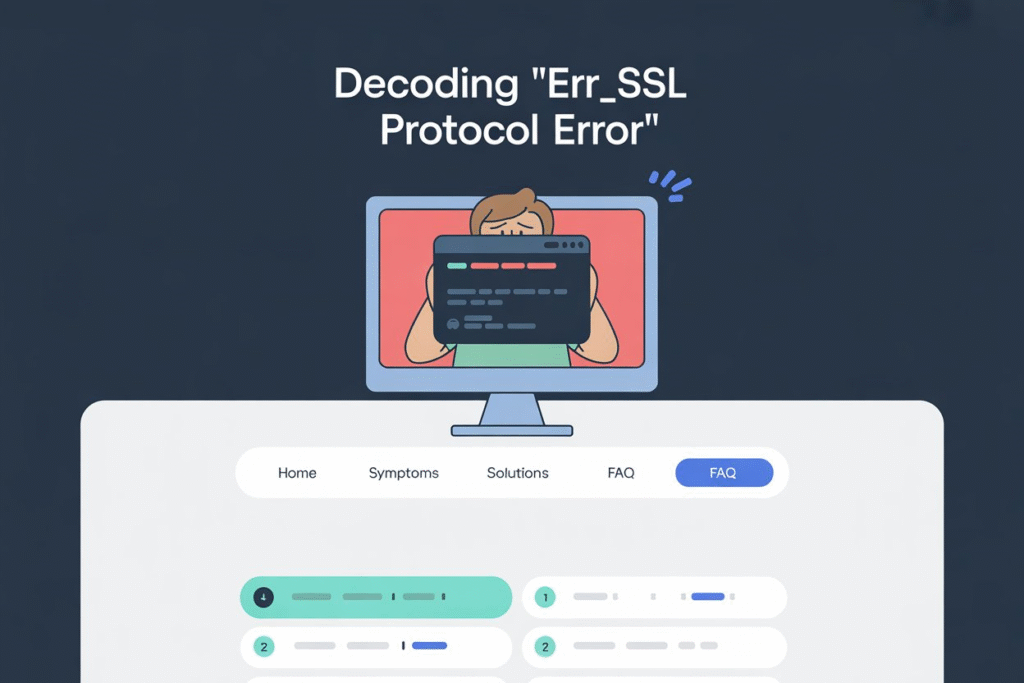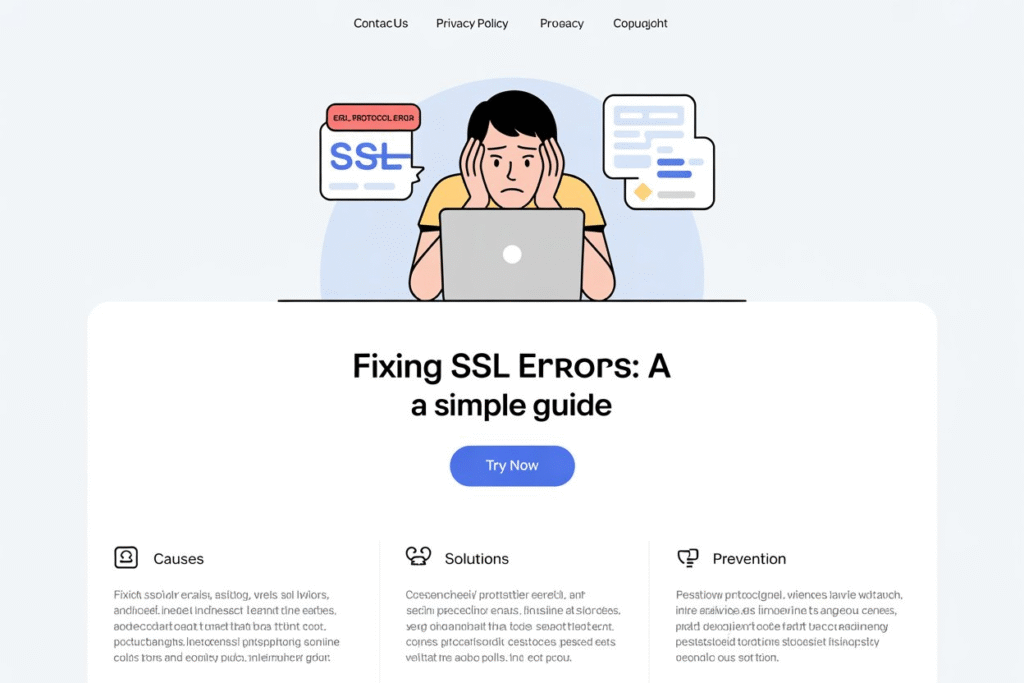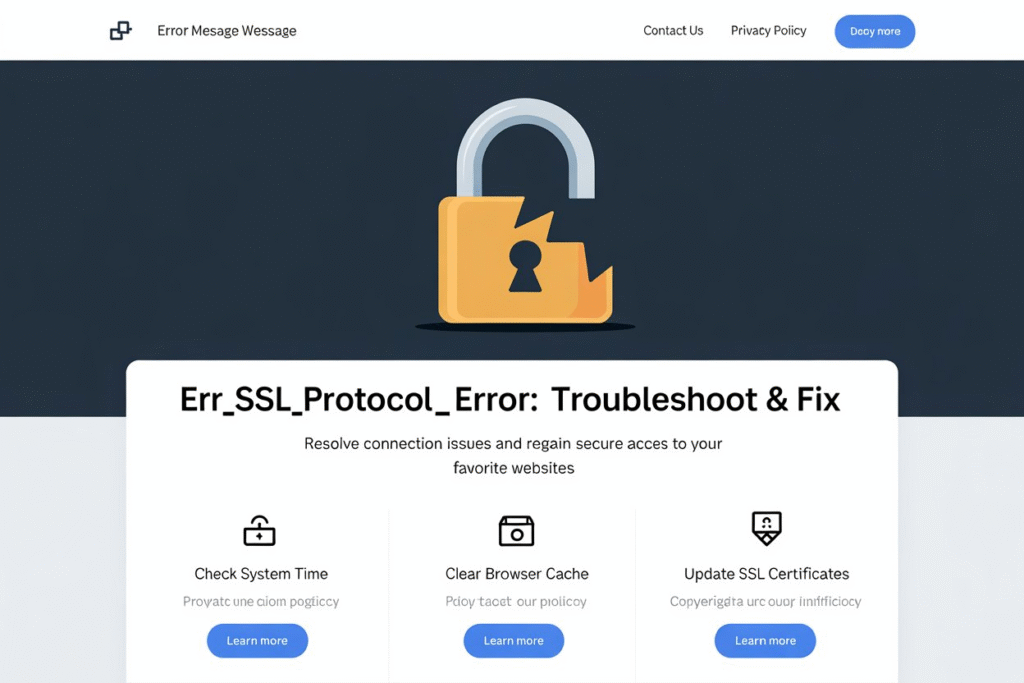
Introduction
Imagine clicking to visit a website, only to be stopped by a frustrating message: “www.xnxx.com sent an invalid response. err_ssl_protocol_error”. This error can feel like a roadblock, preventing you from accessing the content you need. It signals a failure in establishing a secure connection between your browser and the website’s server, often due to SSL/TLS issues. However, this common problem is usually fixable with simple steps. In this guide, we’ll explore what this error means, why it happens, and how to resolve it effectively. Whether you’re a casual user or a website owner, you’ll find clear solutions to get back online securely.
Understanding SSL/TLS
What Are SSL/TLS Protocols?
SSL (Secure Sockets Layer) and TLS (Transport Layer Security) are protocols that encrypt data between your browser and a website’s server. When you visit a site with HTTPS, these protocols ensure your data, like login details or payment information, remains private. The process starts with an SSL/TLS handshake, where the browser verifies the server’s SSL certificate and negotiates encryption methods. If successful, a secure connection is established. However, issues during this handshake can trigger errors like “www.xnxx.com sent an invalid response. err_ssl_protocol_error”. Understanding these protocols helps you diagnose and fix such problems efficiently.
Why Secure Connections Matter
Secure connections are essential for online safety. Without SSL/TLS, data sent between your device and a website could be intercepted, exposing sensitive information like passwords or credit card numbers. These protocols authenticate the website’s identity and encrypt data, ensuring privacy and trust. When an error like “www.xnxx.com sent an invalid response. err_ssl_protocol_error” occurs, it indicates a failure in this security process, potentially compromising user safety. Resolving this error quickly restores secure access, protecting both users and website credibility. For website owners, maintaining secure connections builds user confidence and prevents data breaches.

The SSL/TLS Handshake Process
The SSL/TLS handshake is a critical step in establishing a secure connection. Your browser requests the server’s SSL certificate, which confirms the website’s identity. Both parties then agree on encryption protocols and cipher suites. If everything aligns, data transfer begins securely. However, issues like outdated protocols, invalid certificates, or mismatched settings can disrupt this process, leading to errors such as “www.xnxx.com sent an invalid response. err_ssl_protocol_error”. Knowing how this handshake works allows you to pinpoint the cause and apply targeted solutions to restore a secure connection.
What is “err_ssl_protocol_error”?
Defining the Error
The error “www.xnxx.com sent an invalid response. err_ssl_protocol_error” appears when a browser fails to establish a secure connection with a website. It typically occurs during the SSL/TLS handshake, where the browser and server cannot agree on encryption protocols or verify the server’s identity. This results in a message like “This site can’t provide a secure connection” in browsers like Chrome or Edge. The error isn’t unique to any specific website and can stem from user-side issues, like outdated browsers, or server-side problems, such as misconfigured SSL certificates. Identifying the cause is key to fixing it.
Common Causes
Several factors can trigger this error:
- Outdated Browser: Your browser may not support modern SSL/TLS versions required by the website.
- Invalid SSL Certificate: The website’s certificate might be expired, revoked, or improperly installed.
- Server Misconfiguration: Incorrect server settings, like outdated TLS versions, can prevent a successful handshake.
- Incorrect System Time: SSL certificates rely on accurate timestamps; wrong system time can cause validation failures.
- Browser Cache Issues: Corrupted cache or cookies might disrupt SSL connections.
- Security Software: Firewalls or antivirus programs can block SSL traffic, leading to errors like “www.xnxx.com sent an invalid response. err_ssl_protocol_error”.
These causes provide a starting point for troubleshooting.
Variations Across Browsers
The error message varies by browser. In Google Chrome, you’ll see “This site can’t provide a secure connection” with “err_ssl_protocol_error”. Microsoft Edge might display “Can’t connect securely to this page.” Firefox may show “Secure Connection Failed.” Despite different wording, the issue is the same: a failed SSL/TLS handshake. Recognizing these variations helps you identify the error across platforms and apply consistent fixes. For instance, troubleshooting steps for “www.xnxx.com sent an invalid response. err_ssl_protocol_error” in Chrome will generally work for similar errors in other browsers.
Why Does This Error Occur on Specific Websites?
Website-Specific Factors
While “www.xnxx.com sent an invalid response. err_ssl_protocol_error” can occur on any site, certain website-specific issues might contribute. The site could use outdated SSL/TLS protocols incompatible with modern browsers. An expired or misconfigured SSL certificate might also be the culprit. Additionally, server maintenance or temporary outages can disrupt SSL handshakes. For websites using Content Delivery Networks (CDNs), improper SSL settings on the CDN can cause errors. These factors might explain why the error appears on specific sites, but the solutions remain broadly applicable.
Regional and Network Issues
Regional network restrictions or ISP policies can sometimes trigger SSL errors. For example, some ISPs may block certain websites or interfere with SSL traffic, leading to errors like “www.xnxx.com sent an invalid response. err_ssl_protocol_error”. Using a VPN can bypass such restrictions by routing your connection through a different server. Temporary network glitches or server downtime can also cause this error, particularly if the website’s infrastructure is under strain. Checking these factors helps determine if the issue is local or tied to the website’s server.
User-Side Contributions
On the user’s end, device or browser settings can play a role. An outdated browser might not support the website’s SSL/TLS requirements. Incorrect system time can invalidate certificate checks, as SSL certificates depend on accurate timestamps. Browser extensions or antivirus software might also interfere with secure connections. For instance, an overzealous firewall could block SSL traffic, resulting in “www.xnxx.com sent an invalid response. err_ssl_protocol_error”. Addressing these user-side issues often resolves the error without needing to involve the website’s support team.

Troubleshooting “err_ssl_protocol_error”
Verify System Date and Time
Incorrect system time can cause SSL certificate validation to fail, as certificates have specific validity periods. To fix this, ensure your device’s date and time are accurate. On Windows, right-click the taskbar clock, select “Adjust date/time,” and enable “Set time automatically.” On macOS, go to System Preferences > Date & Time, and check “Set date and time automatically.” For mobile devices, navigate to Settings > Date & Time and enable automatic settings. This step often resolves “www.xnxx.com sent an invalid response. err_ssl_protocol_error” by aligning your device with the website’s certificate timestamps.
Clear Browser Cache and Cookies
Corrupted browser data can disrupt SSL connections. To clear cache and cookies in Chrome, go to Settings > Privacy and security > Clear browsing data, and select “Cookies and other site data” and “Cached images and files.” In Firefox, navigate to Options > Privacy & Security > Cookies and Site Data > Clear Data. For Edge, go to Settings > Privacy, search, and services > Clear browsing data. After clearing, restart your browser and try accessing the site again. This can fix “www.xnxx.com sent an invalid response. err_ssl_protocol_error” caused by corrupted data.
Update Your Browser
An outdated browser may not support modern SSL/TLS protocols, leading to handshake failures. To update Chrome, go to Settings > About Chrome, where it checks for updates automatically. For Firefox, navigate to Help > About Firefox to trigger an update check. In Edge, go to Settings > About Microsoft Edge. Updating ensures compatibility with current security standards, potentially resolving “www.xnxx.com sent an invalid response. err_ssl_protocol_error”. Regular updates also enhance browser security and performance, making this a critical step.
Disable Browser Extensions
Browser extensions can interfere with SSL connections. To test this, disable extensions temporarily. In Chrome, go to Settings > Extensions and toggle off each extension. In Firefox, navigate to Add-ons and Themes > Extensions and disable them. For Edge, go to Extensions and turn them off. After disabling, try accessing the website. If the error “www.xnxx.com sent an invalid response. err_ssl_protocol_error” disappears, re-enable extensions one by one to identify the problematic one. This approach isolates issues without disrupting your browsing setup.
Check Firewall and Antivirus Settings
Firewalls or antivirus software can block SSL connections. Temporarily disable these to test if they’re causing “www.xnxx.com sent an invalid response. err_ssl_protocol_error”. On Windows, go to Control Panel > Windows Defender Firewall > Turn Windows Defender Firewall on or off. For antivirus programs, check their settings to disable temporarily. Be cautious, as disabling security software increases risk. If the error resolves, adjust settings to allow SSL traffic. This step can pinpoint and fix interference from security tools.

Try a Different Browser or Device
If the error persists, test the website on another browser, like Firefox or Edge, or a different device. This helps determine if the issue is specific to your setup. If “www.xnxx.com sent an invalid response. err_ssl_protocol_error” only appears in Chrome, the problem might be Chrome-specific settings. If it occurs on one device but not another, your device’s configuration or network might be at fault. This diagnostic step clarifies whether the issue is user-side or server-side.
Verify SSL Certificate (For Website Owners)
If you manage a website, ensure your SSL certificate is valid, not expired, and matches the domain name. Check that your server supports modern TLS versions, like TLS 1.2 or 1.3, and uses secure cipher suites. Tools like SSL Labs’ SSL Test can analyze your configuration. Fixing certificate or server issues can eliminate “www.xnxx.com sent an invalid response. err_ssl_protocol_error” for users, ensuring a secure and trustworthy website experience.
Contact Hosting Provider
If user-side fixes don’t work, the issue might be server-side. Contact the website’s hosting provider or support team, providing details like your browser, device, and error occurrence time. For website owners, consult your hosting provider to check server logs for SSL-related errors. This step can resolve “www.xnxx.com sent an invalid response. err_ssl_protocol_error” when the problem lies beyond user control, ensuring quick restoration of secure access.
Pros and Cons of Troubleshooting Methods
| Method | Pros | Cons |
|---|---|---|
| Verify System Date/Time | Quick, easy, no risk | May not resolve server-side issues |
| Clear Cache/Cookies | Simple, often effective | Clears saved login data |
| Update Browser | Enhances security and compatibility | Requires internet connection |
| Disable Extensions | Isolates problematic extensions | Time-consuming to test each extension |
| Check Firewall/Antivirus | Resolves interference quickly | Temporarily reduces security |
| Try Different Browser/Device | Identifies setup-specific issues | Not a permanent solution |
| Verify SSL Certificate | Fixes server-side issues for owners | Requires technical knowledge |
| Contact Hosting Provider | Addresses server-side problems | May involve delays in response |
Preventing Future Errors
Regular Browser Updates
Keep your browser updated to support the latest SSL/TLS protocols. Regular updates fix bugs and ensure compatibility, reducing the chance of errors like “www.xnxx.com sent an invalid response. err_ssl_protocol_error”. Check for updates monthly to stay secure.
Maintain Accurate System Time
Ensure your device’s date and time update automatically. This prevents SSL certificate validation issues, a common cause of protocol errors. Regularly verify your system settings to avoid disruptions.
Monitor SSL Certificates
For website owners, check your SSL certificate’s validity and renewal dates. Set reminders to renew before expiration. Automated monitoring tools can help prevent errors like “www.xnxx.com sent an invalid response. err_ssl_protocol_error”.
Stay Informed on Security
Follow updates from browser and operating system providers. Security advisories highlight changes in SSL/TLS standards, helping you avoid errors. Engaging with online tech communities can also provide insights into common issues and solutions.
FAQs
What does “err_ssl_protocol_error” mean?
This error indicates a failure in the SSL/TLS handshake, preventing a secure connection between your browser and the website’s server.
Is this error specific to certain websites?
No, it can occur on any website due to SSL/TLS issues, user-side settings, or server misconfigurations.
Can I fix this error myself?
Yes, steps like checking system time, clearing cache, updating browsers, or disabling extensions often resolve the issue.
What if the error persists after all fixes?
If server-side issues are the cause, contact the website’s support or your hosting provider for assistance.
Conclusion
The error “www.xnxx.com sent an invalid response. err_ssl_protocol_error” can disrupt your online experience, but it’s a solvable problem. By understanding its causes—ranging from outdated browsers to server misconfigurations—you can apply targeted fixes like updating your browser, clearing cache, or verifying SSL certificates. This guide provides practical steps for users and website owners to restore secure connections. Don’t let this error hold you back. Start troubleshooting now to ensure safe, uninterrupted browsing. Ready to fix this issue? Follow these steps and get back online securely today!


